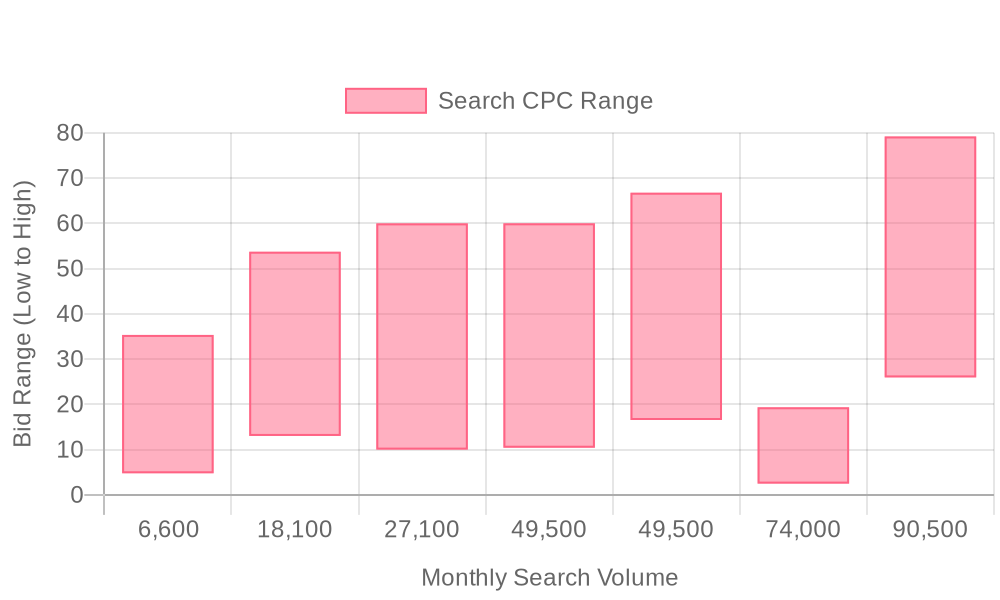
Supercharge your lead generation with a FREE Google Ads audit - no strings attached! See how you can generate more and higher quality leads
Get My Free Google Ads AuditFree consultation

No commitment
Supercharge your lead generation with a FREE Google Ads audit - no strings attached! See how you can generate more and higher quality leads
Get My Free Google Ads AuditFree consultation

No commitment
In today's digital-first world, online education providers face unique challenges in capturing the attention of prospective students. Navigating the digital landscape, especially with tools like Google Ads, can significantly amplify your reach and impact. You're not just enhancing visibility; you're connecting with learners right when they're actively seeking the educational services you offer. This guide delves into leveraging Google Ads to boost enrollments, integrate seamlessly with your broader marketing ecosystem, and achieve measurable ROI. Let’s explore strategic methods to set up, optimize, and elevate your online education business through Google Ads.

Online education providers can capture sustained, high-quality lead flow by elevating every stage of their Google Ads strategy. Clear objectives, precise audience targeting, and agile measurement practices drive more consistent results than generic, siloed campaigns. Platforms that unify go-to-market data empower teams to identify high-intent prospects and deliver engagement at the right moment, transforming disconnected efforts into a streamlined pipeline.
Generating leads through Google Ads for online education is a dynamic process that demands more than keyword bidding and basic analytics. Success hinges on connecting campaign goals to user intent, building audience lists that adapt in real time, and attributing conversions accurately across the entire student journey. When marketing and sales systems are seamlessly integrated, revenue teams can prioritize in-market accounts, synchronize messaging, and rapidly scale what’s working.
By systematically addressing each of these areas, online education brands can drive more efficient lead generation, reduce wasted ad spend, and build a scalable framework for growth. Ready to take the next step? Get started for free with Sona.

Online education providers operate in a highly competitive landscape where standing out requires more than just compelling course content. Google Ads provides a direct path to visibility by connecting motivated learners with the programs and certifications they are actively searching for.
Ready to transform your student acquisition strategy? Get started for free with Sona.


Growth in online education relies on uncovering overlooked audiences and personalizing interactions across the marketing funnel. By leveraging data-driven tactics, education providers can move beyond generic outreach and create touchpoints that resonate with the right learners at the right time.
Combining these tactics gives online education marketers the ability to transform anonymous website activity into actionable growth opportunities. Advanced platforms unify visitor identification and real-time engagement data, making it possible to sync enriched lead profiles directly into Google Ads and CRM systems. This bridges the gap between digital engagement and enrollment outcomes, supporting both short-term campaign performance and long-term revenue growth for educational organizations. Ready to put these strategies into action? Get started for free with Sona.

Online education providers face high competition and sophisticated buyer journeys, making precise audience segmentation essential for maximizing campaign performance. Segmentation enables marketers to deliver relevant messaging to each user group, improving engagement rates and driving more qualified leads for online courses and degree programs. For additional strategies on elevating your campaigns, visit the Sona blog.

| Industry | Keyword | Monthly Search Volume | Competition Level | Low Bid | High Bid |
| Online Education | online education | 6600 | LOW | 4.78 | 35.34 |
| Online Education | best online colleges | 18100 | HIGH | 13.02 | 53.72 |
| Online Education | online school programs | 27100 | HIGH | 10 | 59.99 |
| Online Education | online school | 49500 | HIGH | 10.42 | 60 |
| Online Education | online college courses | 49500 | HIGH | 16.55 | 66.76 |
| Online Education | k12 online school | 74000 | MEDIUM | 2.49 | 19.36 |
| Online Education | online colleges | 90500 | HIGH | 25.96 | 79.19 |
A robust keyword strategy is the foundation of every successful Google Ads for Online Education initiative. B2B education marketers gain a competitive advantage by tailoring campaigns to match the language, intent, and search context of their prospective students or enterprise buyers. For further guidance, explore this overview of Google Ads strategies.
A strategic approach to keywords—blending broad reach with precision targeting—delivers measurable improvements in campaign efficiency, student acquisition, and marketing ROI. Using unified data from across the funnel, marketers can continuously refine their keyword approach, making every click count toward their business goals in online education. To see how unified data can supercharge your campaigns, get started for free with Sona.
A methodical approach to Google Ads for online education transforms scattered campaign management into a source of predictable, scalable growth. Online education providers face unique pressures: high-value leads often cool quickly when campaign workflows are disconnected or manual, and marketing teams struggle to connect ad engagement to real enrollment outcomes. A unified campaign execution framework addresses these challenges, streamlining each step from keyword research through real-time optimization and attribution.
Keyword selection is the foundation of every successful Google Ads campaign in online education. Organizing keywords by course type and segmenting audiences by learning objectives, job roles, or industry focus ensures that campaigns reach the right prospects at the right time. Incorporating firmographic data—such as company size, sector, or technology adoption—enables marketers to create highly specific keyword groups that reflect the decision-making environment of prospective students. By moving beyond generic search terms and aligning keywords with unique program attributes and buyer personas, education marketers can raise quality scores, reduce wasted spend, and increase qualified lead volume.
When visitor identification capabilities are integrated into the workflow, marketers can see which companies and individuals are searching for specific programs. This allows for hyper-targeted keyword expansion and negative keyword refinement based on actual in-market behaviors, ensuring spend is allocated to audiences most likely to convert. For a practical overview of Google Ads strategies tailored for course providers, explore this resource.
Effective ad copy for online education must speak directly to the pain points of modern learners and decision-makers. Identifying these challenges—such as career advancement, upskilling, or flexible learning modalities—lets marketers craft messaging that addresses real obstacles and aspirations. Messaging should align with the user’s stage in the enrollment journey, from awareness (“Advance your career with accredited online courses”) to consideration (“Flexible, instructor-led programs for working professionals”) and decision (“Apply now for next cohort, limited seats available”). This level of specificity not only boosts click-through rates but also ensures that ad spend results in meaningful engagement.
When marketing teams harness real-time intent data, they can dynamically adjust ad messaging as leads move through the funnel. Audiences who have engaged with curriculum pages or started applications can be surfaced with ads focused on deadlines, financial aid, or student testimonials, driving urgency and personal relevance.
Landing pages for Google Ads in online education must create a frictionless path from ad click to inquiry or enrollment. Alignment between ad messaging and landing page content is critical: prospects should immediately see the course, benefit, or outcome promised in the ad. Elements such as clear calls-to-action, program highlights, student outcomes, and interactive elements help sustain engagement and drive conversions. Personalization—showcasing relevant courses or testimonials based on the ad or visitor segment—further improves conversion rates and reduces bounce.
Marketers equipped with advanced analytics can identify which segments engage most deeply and where drop-off occurs, allowing for continuous landing page refinement. By mapping anonymous and known visitor journeys, teams gain granular insights into which messages, formats, and offers drive actual applications, not just clicks.
Continuous, data-driven optimization is essential for maximizing Google Ads ROI for education. Campaign performance should be monitored at both the keyword and audience level, with adjustments made based on behavioral patterns, engagement depth, and offline conversion data. Automated rules can shift budgets toward high-converting programs or geographies, while underperforming segments are paused or retooled.
Advanced conversion tracking, including online and offline attribution, provides a holistic understanding of which campaigns generate true enrollments versus surface-level engagement. Connecting CRM and ad platforms enables revenue teams to sync enriched audiences, update retargeting lists as leads progress, and ensure that marketing and sales are always aligned on high-intent opportunities. This closed-loop approach ensures marketing efforts are continually refined for maximum impact, driving measurable growth in enrollments and ROI for online education providers. If you’re ready to see how this can work for you, get started for free with Sona.
Scaling your online education brand requires more than increasing ad spend. The key is to create consistent, high-value experiences that guide prospects from initial discovery to long-term engagement. For expert insights on optimizing campaigns, explore this overview of Google Ads strategies for online courses, or dive deeper into marketing analytics best practices for sustained growth.
A fragmented message or poorly sequenced touchpoints can erode trust and lower conversion rates. Strategic expansion, supported by the right data insights, ensures every interaction reinforces your institution’s reputation and value proposition.
Harnessing the power of Google Ads for Online Education ensures your institution remains visible and competitive in a crowded digital landscape. By executing cross-channel strategies with real-time data, you not only attract motivated learners but also support them throughout their educational journey. When every message, audience, and metric is unified, you position your brand as a trusted partner in lifelong learning. If you’re ready to modernize your online education marketing, get started for free with Sona.
Navigating the world of Google Ads for online education can be a transformative journey for your brand. By leveraging the right strategies and tools, you can effectively reach your target audience and maximize the impact of your educational offerings.
Throughout this article, we've explored the critical steps involved in setting up Google Ads, discussed effective targeting strategies, and highlighted best practices for crafting compelling ad copy. These insights equip you with the knowledge to create campaigns that resonate with potential learners and drive meaningful engagement.
Embrace this opportunity to elevate your marketing efforts and unlock new possibilities for growth. By implementing these strategies, you can enhance your brand's presence and inspire more students to engage with your courses.
We invite you to start for free and explore how our platform can help you unify your go-to-market data, providing actionable insights that propel your educational initiatives forward.
Best practices include setting clear objectives, optimizing keyword strategy, designing high-converting ads, creating aligned landing pages, and tracking metrics such as conversions to measure success.
Begin by building targeted keyword lists segmented by course type, develop resonating ad copy, design seamless landing pages, and implement data-driven optimizations.
The budget should be focused on high-intent keyword groups and adjusted dynamically based on campaign performance and audience engagement to ensure efficient spend.
Improve targeting by using precise audience segmentation, overlaying intent signals, customizing creative per segment, and leveraging vertical keyword targeting.
Track conversion rates, click-through rates, bounce rates on landing pages, and ROI through robust conversion tracking and attribution across multiple touchpoints.
Join results-focused teams combining Sona Platform automation with advanced Google Ads strategies to scale lead generation

Connect your existing CRM

Free Account Enrichment

No setup fees
No commitment required

Free consultation

Get a custom Google Ads roadmap for your business
Join results-focused teams using Sona Platform automation to activate unified sales and marketing data, maximize ROI on marketing investments, and drive measurable growth

Connect your existing CRM

Free Account Enrichment

No setup fees
No commitment required

Free consultation

Get a custom Google Ads roadmap for your business
Over 500+ auto detailing businesses trust our platform to grow their revenue
Join results-focused teams using Sona Platform automation to activate unified sales and marketing data, maximize ROI on marketing investments, and drive measurable growth

Connect your existing CRM

Free Account Enrichment

No setup fees
No commitment required

Free consultation

Get a custom Google Ads roadmap for your business
Over 500+ auto detailing businesses trust our platform to grow their revenue
Join results-focused teams using Sona Platform automation to activate unified sales and marketing data, maximize ROI on marketing investments, and drive measurable growth

Connect your existing CRM

Free Account Enrichment

No setup fees
No commitment required

Free consultation

Get a custom Google Ads roadmap for your business
Over 500+ auto detailing businesses trust our platform to grow their revenue
Join results-focused teams using Sona Platform automation to activate unified sales and marketing data, maximize ROI on marketing investments, and drive measurable growth

Connect your existing CRM

Free Account Enrichment

No setup fees
No commitment required

Free consultation

Get a custom Google Ads roadmap for your business
Over 500+ auto detailing businesses trust our platform to grow their revenue
Our team of experts can implement your Google Ads campaigns, then show you how Sona helps you manage exceptional campaign performance and sales.
Schedule your FREE 15-minute strategy sessionOur team of experts can help improve your demand generation strategy, and can show you how advanced attribution and data activation can help you realize more opportunities and improve sales performance.
Schedule your FREE 30-minute strategy sessionOur team of experts can help improve your demand generation strategy, and can show you how advanced attribution and data activation can help you realize more opportunities and improve sales performance.
Schedule your FREE 30-minute strategy sessionOur team of experts can help improve your demand generation strategy, and can show you how advanced attribution and data activation can help you realize more opportunities and improve sales performance.
Schedule your FREE 30-minute strategy sessionOur team of experts can help improve your demand generation strategy, and can show you how advanced attribution and data activation can help you realize more opportunities and improve sales performance.
Schedule your FREE 30-minute strategy session





Launch campaigns that generate qualified leads in 30 days or less.
